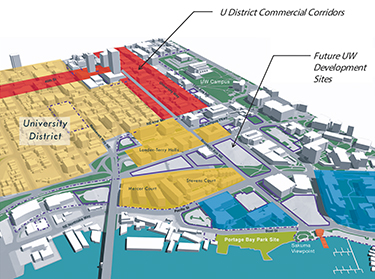|
Subscribe / Renew |
|
|
Contact Us |
|
| ► Subscribe to our Free Weekly Newsletter | |
| home | Welcome, sign in or click here to subscribe. | login |
Architecture & Engineering
| |
January 29, 2016
Walker Macy designs a new city park on Portage Bay that will open in 2018
Journal Staff Reporter
The city of Seattle expects to start construction in late 2017 on a 1.65-acre park along Portage Bay on land now occupied by the old Bryant's Marina/UW Police Facilities.
Walker Macy designed the park with a terraced lawn to create an amphitheater-like setting on the water.
The park will have a beach, hand-carry boat launch, piers, bike racks and interpretive elements that celebrate the site's Native American and maritime history. Restrooms and picnic tables may also be added.
“We're trying to pack a big punch in a really small site,” said Lara Rose, a Walker Macy principal and landscape architect.
A public meeting on the project is set for 6:30 p.m. Feb. 9 at the Bryant Building, 1117 N.E. Boat St. The park is expected to be complete in 2018, said David Graves, a strategic advisor with Seattle Parks and Recreation.
The park will be near University of Washington dorms as well as academic and medical buildings, and two blocks from the Burke-Gilman Trail.
Rose said the south-facing park should be popular because it will get lots of sun and offer people a chance to get in the water. “It will become the primary waterfront park for the U District community,” she said.
Visitors will arrive by land as well as kayaks and canoes.
Agua Verde Cafe & Paddle Club is next door, and Rose said the city will encourage food trucks to park on Northeast Boat Street near the park.
Interpretive elements will highlight the site's Native American history as well as its past as a Chris-Craft boat manufacturing plant.
The shoreline will be restored with native plants and shallow gravel beach areas to provide refuge for salmon as they migrate upstream.
The project team asked UW students, faculty and staff what they wanted in the park. They said a sustainable place that celebrates the history, Rose said, but “the water connection was first and foremost.”
On Feb. 3 Seattle's Landmarks Preservation Board will consider nomination of Bryant's Marina/UW Police Facilities as a city landmark, but Graves said a landmark designation will not preclude demolition because of prior agreements about the park between the city, state and federal government.
The park is the result of a deal between the city, UW and the Washington State Department of Transportation.
Graves said the city bought the site between Portage Bay and Northeast Boat Street from the UW using money it got from WSDOT as mitigation for the SR 520 expansion project.
In addition to the 33,000-square-foot, 1922-vintage Bryant Building, the site has a wood-frame storage structure built in the 1940s.
A 2012 environmental assessment prepared by SoundEarth Strategies said the parcel was home to a lumber mill from the early 1900s to about 1950, when it was converted to boat storage. The mill was demolished in 1977.
The report said the site was used for building and repairing boats until the late 1960s, and a marine fuel station operated on the western portion from the early 1960s to the late 1980s. Underground fuel tanks were removed in 1992 and the site was remediated.
Graves said the city will use $2.3 million from the UW to remediate VOCs and metals on the site and $9 million from WSDOT to develop the park.
The UW will continue to operate a nearby marina and is constructing a new police station a few blocks away, Graves said.
He said the city looked at 80 potential sites for the park.
Walker Macy is the landscape architect and prime consultant. The team also includes Aqua Terra Cultural Resource Consultants, cultural resources; BOLA Architecture + Planning, architectural historical resources; dark|light design, lighting design; Grette, environmental permitting; JMB Consulting Group, cost estimating; KPFF Consulting Engineers, marine engineer, structural engineer and survey; Lehrman Cameron Studio, interpretive design; Maul Foster Alongi, environmental remediation; Merit Engineering, geotechnical engineer; Osborne Consulting, civil engineer; Schemata Workshop, architect; Stepherson & Associates Communications, public outreach; and Tres West Engineers, electrical engineer.
Lynn Porter can be
reached by email or by phone
at (206) 622-8272.



